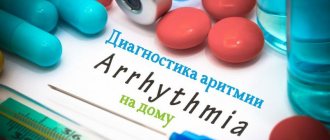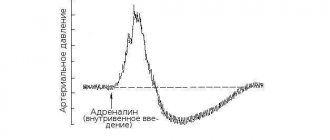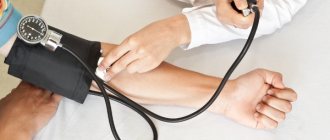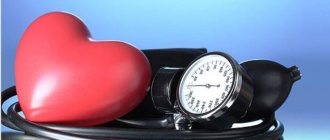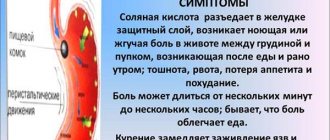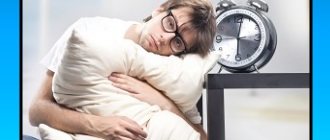What is arrhythmia? Causes and treatment of arrhythmia at home
Arrhythmia is a violation of the frequency, rhythm and/or sequence of contractions of the heart. The term combines heartbeat disturbances that are different in their causes, clinical manifestations and consequences: increased heart rate (> 100 beats/min, tachycardia); slowing (<60 beats/min, bradycardia); irregularity (extrasystole).
To understand what cardiac arrhythmia is and why it occurs, you need to understand what natural mechanisms continuously maintain the heart rhythm throughout life.
Causes of cardiac arrhythmia
In practically healthy people, arrhythmia can occur due to overheating, being in a stuffy room, overeating, and also as a result of taking certain medications.
There is a high risk of this disease in patients suffering from diabetes, hypertension, and obesity. In women, arrhythmia is often detected during menopause and pregnancy, which is a temporary condition.
Much more serious causes are heart diseases: myocarditis, coronary disease, heart defects, myocardial infarction, malignant neoplasms. In these cases, arrhythmia is an indicator to which the doctor must pay close attention in order to prescribe the correct timely treatment.
Causes of arrhythmia in women and men
Arrhythmias, in most cases, develop against the background of other myocardial lesions and concomitant disruption of the conduction system of the heart. In this case, dysfunction of both the cells that generate the impulse and those that conduct it through various parts of the organ is possible. Most often this is:
- Coronary heart disease and its complication in the form of myocardial infarction.
- Cardiomyopathy - thickening or thinning of the walls of the heart, their deformation, excessive expansion of the atria or ventricles.
- Congenital defects of the heart and its valves.
- Inflammation of the heart and its membranes - myocarditis, endocarditis, pericarditis.
- Previously undergone heart surgery.
Separately, provoking factors are identified that directly or indirectly contribute to the occurrence of heart rhythm disturbances. These include:
- Arterial hypertension and heart failure.
- Severe infectious diseases that can affect the heart: diphtheria, streptococcal tonsillitis, etc.
- Endocrine diseases: hyperthyroidism and hypothyroidism (excessive and insufficient production of thyroid hormones), diabetes mellitus.
- Chronic stress and psycho-emotional stress.
- Bad habits: abuse of alcoholic beverages and tobacco products.
- Taking certain medications from the antidepressant group, including antipsychotics and antiarrhythmic drugs.
- Hereditary tendency to arrhythmias.
In women, arrhythmias can be associated with sharp hormonal fluctuations, for example, during the first menstruation, pregnancy, transition to menopause, as well as with uncontrolled, improper use of oral contraceptives.
Classification
In medicine, there are several types of arrhythmias - each of them has different symptoms and course, so it is necessary to diagnose not just the arrhythmia, but also its specific type - the choice of therapeutic therapy will depend on the results.
- Sinus arrhythmia. Most often diagnosed in childhood and adolescence, it is characterized by an abnormal alternation of heart beats. With this type of disorder in question, no specific treatment is required, the patient’s condition is not disturbed, and the normal rhythm of the heartbeat can be quickly restored by simply holding the breath for a few seconds.
- Sinus tachycardia is diagnosed if the heart rate exceeds 90 beats/min, of course, for no apparent reason (running, exercise, excitement). Typically, with such tachycardia, the heart rate does not exceed 160 beats per minute under calm conditions, and only during intense exercise can it reach up to 200 beats. It is caused by many factors associated with pathological processes in the body, therefore the treatment of such tachycardia is aimed at the underlying disease;
- Sinus bradycardia. This type of arrhythmia is manifested by a decrease in heart rate - in a patient this figure may be less than 55 beats per minute.
- Paroxysmal tachycardia, similar to extrasystole, developing suddenly and also suddenly stopping, is characterized by a regular, strict rhythm, although the contraction frequency can reach 240 beats/min (atrial) or pronounced changes in hemodynamics (ventricular);
- Flickering arrhythmia. Doctors characterize this type of arrhythmia as fluttering in the chest - the heart begins to contract faster (up to 150 beats per minute), then even faster (up to 300 beats per minute), the atria do not contract completely, and the ventricles do so irregularly.
Ventricular flutter and fibrillation are considered the most life-threatening manifestations of arrhythmia. This usually occurs against the background of heart pathologies, electric shock, or taking certain medications.
Cardiac arrhythmia - what is it and how to treat it? Make an appointment with a cardiologist at MEDSI Clinic
Table of contents
- Causes
- Classification
- Symptoms
- Arrhythmia during pregnancy
- Diagnostics
- Treatment
- Drug treatment of cardiac arrhythmia
- Cardiac arrhythmia: treatment with surgery
- Consequences
- Prevention
- Forecast
- Advantages of treatment at MEDSI
Cardiac arrhythmia
is a pathology associated with disturbances in the rhythm, frequency and sequence of heart contractions. The disease can be a consequence of both diseases of the heart itself and disturbances in the functioning of other organs and systems. Malfunctions of the heart are very dangerous, as they can cause both serious health problems and death of the patient. That is why treatment of arrhythmia should begin as early as possible, when the first attack occurs. You should not think that it is a one-off and will never happen again!
Causes
To the main causes of arrhythmia
heart problems include functional dysregulation and anatomical changes. Very often, rhythm disturbances are a sign of illness.
Arrhythmia can be provoked
:
- Coronary heart disease
- Injuries
- Surgical interventions
- Heart defects
- Myocarditis, etc.
There are also third-party (non-cardiac) factors that can cause rhythm disturbances.
These include:
- Addiction to drinks and foods containing large doses of caffeine
- Energy drink craze
- Excessive alcohol consumption
- Frequent smoking
- Stress
- Metabolic disorders
- Fungal infections
- Excessive exercise
- Infections
- Climax
- Brain pathologies
In most cases, the causes of cardiac arrhythmia are quickly identified, allowing treatment to begin immediately. In some situations, it is impossible to identify factors contributing to the development of pathology. Such conditions are called idiopathic.
Classification
Today, experts have identified several types of arrhythmias:
- Sinus tachycardia.
With this pathology, the heart rate is more than 90 beats per minute. The patient experiences unpleasant sensations; he literally feels how hard his heart is beating. Some call this condition “the heart is jumping out of the chest” - Sinus arrhythmia
. With this pathology, heart contractions alternate incorrectly. Typically this form of the disease is diagnosed in children and adolescents - Sinus bradycardia
. This pathology is characterized by a pulse rate of less than 55 beats per minute and can occur even in completely healthy people during sleep or rest. - Atrial fibrillation
. This pathology is characterized by a regular rhythm with a very rapid (up to 240 beats per minute) heartbeat. Patients suffer from weakness and increased sweating. Some patients become faint during an attack - Paroxysmal tachycardia
. With this pathology, the heart rate increases (up to 140-220 beats per minute). The attack begins suddenly and ends just as quickly - Extrasystole
. This pathology is characterized by premature contractions of the heart. During an attack, the patient feels freezing or tremors of the heart muscle
Symptoms
Symptoms of arrhythmia largely depend on its type and are determined by the rhythm and frequency of the heart.
To the main features
pathological conditions include:
- Feeling of heart failure
- Increased heart rate
- Weakness
- Dizziness
In some cases, attacks are accompanied by suffocation, fainting and general discomfort.
Important! In some cases, “silent” arrhythmias are diagnosed. With this pathology, the patient does not experience any symptoms. The disease is discovered accidentally, usually during an ECG examination during medical examination or diagnosis of other pathological conditions.
Arrhythmia during pregnancy
Pregnancy is a special state of the body, which is characterized by various changes in the functioning of both individual organs and entire systems. While carrying a child, a woman may experience heart rhythm disturbances. Almost 20% of pregnant women, for example, experience tachycardia and extrasystole. At the same time, we cannot talk about heart pathologies.
If you suffer from a disease, but still want to become a mother, you should:
- Strictly follow all doctor's recommendations
- Maintain a rest and work schedule
- Take all prescribed medications
- Receive inpatient therapy in a timely manner
Childbirth in women with arrhythmia usually takes place in specialized departments, where immediate assistance can be provided for cardiac pathologies.
Diagnostics
Diagnosis of cardiac arrhythmia, as well as treatment, is always carried out comprehensively.
The examination includes:
- Audition at the first appointment
- Taking an ECG
- Taking blood and urine tests
The initial examination allows us to determine the heart rhythm, the sequence and frequency of heart contractions, the general health of the patient, and the presence of factors that could trigger the development of the pathological condition.
If arrhythmia occurs spontaneously and does not depend on activity and time of day, Holter monitoring is performed. This technique involves recording the heartbeat around the clock using special equipment. Studies are also carried out under load (on a treadmill or other exercise machine).
To clarify the diagnosis and identify the causes of the pathology, other studies may be carried out.
These include:
- Ultrasound of the heart
- Dopplerography of blood vessels
- Echocardiography, etc.
If necessary, the patient is referred for consultation to other specialists (endocrinologist, gynecologist, etc.).
Treatment
Treatment of cardiac arrhythmia is always carried out in accordance with:
- The cause of the pathology
- A form of rhythm disturbance
- General condition of the patient
- Identified concomitant pathologies
In some cases, it is very important to correct the underlying disease. Only after this can therapy be carried out directly.
Drug treatment of cardiac arrhythmia
Therapy is carried out using drugs such as:
- Calcium and sodium channel blockers
- Beta blockers
- Vitamin complexes
- Means to improve the functioning of the entire cardiovascular system
Important! It is strictly forbidden to attempt therapy on your own! Arrhythmia, which is treated at home, can cause serious complications and even cause the death of the patient.
Cardiac arrhythmia: treatment with surgery
Operations are performed in cases where medication methods do not give the desired result, and in cases of pronounced changes in the functioning of the heart.
Today can be held:
- Cardiac pacing, which involves applying an electric current to the heart muscle
- Implantation of a special device to regulate heart rate
- Catheter ablation, in which sources of false impulses are cauterized and the heartbeat is normalized
Important! Treatment of cardiac arrhythmia, regardless of the cause, is carried out only by a cardiologist. Even standard medications are often selected under the supervision of a specialist. In severe cases, the selection of medications is carried out in a hospital setting. The patient's condition is constantly monitored, and numerous examinations are carried out regularly. This allows you to prevent deterioration in health and the occurrence of complications, and significantly reduces the risk of death of the patient.
Consequences
Any arrhythmia can be complicated by pathological conditions such as ventricular flutter and fibrillation
. These conditions are equivalent in severity to circulatory arrest and can lead to the death of the patient. In the very first seconds of the attack, weakness develops, and the patient experiences dizziness. Then he loses consciousness and convulsions occur. During an attack, breathing stops, and pulse and blood pressure are not recorded. Clinical death occurs. If resuscitation is not performed, the patient will die.
Complications of arrhythmia are especially dangerous for patients with chronic circulatory failure
. During an attack, the patient experiences shortness of breath and may develop pulmonary edema.
Thromboembolic complications are also common
associated with blockage of important arteries. Such conditions lead to cerebral stroke.
Prevention
To prevent arrhythmia it is necessary:
- Do regular morning exercises or simple sets of exercises throughout the day
- Stick to a proper diet. It is important to saturate the body with the full range of nutrients and eat a nutritious and varied diet. At the same time, you should avoid fried, salted and smoked foods, which place additional stress on the body.
- Maintain a normal weight
- Monitor your blood pressure levels
- To refuse from bad habits
- Track sugar levels
- Lead a calm lifestyle, avoiding stress
- Maintain a work and rest schedule
It is very important to regularly consult a doctor and undergo at least a minimal examination to determine the general condition of the body and existing risk factors for the development of pathological issues.
When the first signs of arrhythmia appear, you need to make an appointment with a cardiologist.
Forecast
Arrhythmias not associated with organic cardiac pathologies are not a threat to the health and life of the patient. The prognosis for them is always favorable. The patient can live with this form of the disease, often without even noticing it (if he follows all the doctor’s recommendations). Atrial fibrillation and a number of other forms are dangerous because they can provoke severe pathologies, including not only heart failure, but also stroke. Atrial flutter and ventricular fibrillation pose an immediate threat to life. The prognosis for such pathologies is the most unfavorable. In numerous cases, without proper medical supervision, the patient dies.
Advantages of treatment at MEDSI
- Qualified specialists. Our doctors (not only cardiologists) regularly undergo training and study new methods of treating arrhythmias
- Possibilities for quick diagnostics. We have our own laboratory, where test results can be obtained in CITO (urgent) mode. We also have modern equipment for instrumental diagnostics
- Opportunities for drug therapy and surgical interventions. Our specialists are ready to select means to stabilize the heart, allowing you to avoid relapses of the disease and complications. Our clinics also have operating rooms for performing endovascular interventions and installing pacemakers and defibrillators
- Using only proven methods and drugs. Treatment of arrhythmia in Moscow in our clinics is carried out using products that meet international standards and have proven their effectiveness
- Attentive attitude towards all patients
- Individual approach
- Comfortable atmosphere in clinics
To make an appointment with a cardiologist, just call +7 (495) 7-800-500. We will schedule you to see a specialist at a convenient time. You don't have to wait in line!
Symptoms of arrhythmia
Manifestations of rhythm changes can either be completely invisible to the patient, or have quite noticeable signs:
- sensations of heartbeats, interruptions;
- increased or slowed heart rate;
- feeling of a sinking heart;
- When blood flow is impaired, dizziness occurs and there may be episodes of loss of consciousness.
Rhythm disturbances can be permanent or occur in the form of paroxysms. In this case, an attack of arrhythmia occurs unexpectedly and also suddenly stops.
Clinical signs of atrial fibrillation
Atrial fibrillation, or atrial fibrillation, is the most common disorder, characterized by an increase in heart rate up to 600 beats per minute.
It can be constant, persistent and paroxysmal. The most common symptoms of atrial fibrillation include rapid heartbeat, shortness of breath, discomfort or stabbing pain in the heart area, increased sweating, increased urination and muscle weakness. Patients complain of a feeling of unreasonable fear, a state of panic, and dizziness and fainting are often observed.
Symptoms of extrasystole
Extrasystole is a heart rhythm disorder characterized by the occurrence of one or more extraordinary contractions of the heart muscle. The most characteristic symptoms of the disease include strong heartbeats, a short stop and a subsequent noticeable shock.
Patients often complain of chest pain, lack of air, feelings of fear and causeless anxiety, and increased sweating. Depending on the location of the source of excitation, extrasystolic heart rhythm disturbances are atrial, ventricular and atrioventricular (atrioventricular).
Why is the heart rhythm disrupted?
The normal heart rate is between 70-80 beats per minute at rest. It can increase with physical activity, various emotional experiences, exposure to medications, and alcohol.
A slowdown in heart rate is observed with general weakness, severe fatigue, in old age, in athletes or during sleep. In addition, various types of disorders can be caused by side effects of medications or diseases of internal organs (for example, pathologies of the nervous system).
Also, arrhythmias can occur due to cardiovascular diseases, among which the main role is played by:
- myocardial damage caused by atherosclerosis of the coronary arteries, inflammatory processes, injuries and other factors;
- lesions of the sinus node in the heart caused by congenital or acquired factors;
- tumors of the heart muscle;
- pericardial lesions. We are talking about pericarditis, adhesions, metastases and other problems;
- disturbed balance of electrolytes (deficiency of Mg, K, Ca and Na);
- catheterization, angiography, surgical interventions that irritate the heart.
In addition, the problem in question can also occur in completely healthy people. For example, the loss of one or more beats - in other words, extrasystole - happens to any person from time to time.
Such cardiac failures do not cause inconvenience and are not accompanied by a risk to life and health, unless they become permanent.
Symptoms of sinus bradycardia
This type of arrhythmia is characterized by a heart rate not exceeding 60 beats per minute. Most often, bradycardia develops against the background of organic heart damage. Heart rhythm disturbances (heart rate below 40 beats per minute) are accompanied by weakness, sticky cold sweat, pain in the heart area, dizziness, instability of blood pressure, possible short-term loss or confusion, impaired memory and concentration, short-term visual disturbances.
The most dangerous condition with bradycardia is convulsions (Morgagni-Adams-Stokes attacks), lasting about a minute. In the absence of timely medical assistance, the attack can drag on and lead to respiratory arrest.
Symptoms of paroxysmal tachycardia
Paroxysmal tachycardia is a pathological condition accompanied by paroxysms (attacks of palpitations) with a heart rate of 140-220 beats per minute. A suddenly developing and also suddenly subsiding disturbance of heart pulsation, characterized by a preserved regular rhythm, can have a different duration (from several seconds to several days).
Depending on the location of the source of excitation, paroxysmal tachycardia is divided into 3 forms: atrial, ventricular and atrioventricular. Attacks of arrhythmia are accompanied by dizziness, a feeling of numbness and compression in the chest, in the heart area, and tinnitus. Some patients may experience neurological symptoms (weakening of voluntary movements (hemiparesis), speech impairment). Also characteristic signs of paroxysmal tachycardia include a slight increase in body temperature, nausea, accumulation of gases in the intestines, and increased sweating.
After an attack, the patient develops polyuria (excretion of large amounts of low-density urine). With long-term supraventricular arrhythmia, a drop in blood pressure is observed, severe weakness develops, and fainting is possible.
Normal pulse
In the vast majority of observations, the heart of an adult at rest beats at a rate of 60 to 100 beats per minute. However, there are also other variants of the norm, for example, in people involved in aerobic sports (long-distance running, cycling, swimming), there is a tendency to bradycardia - a slow heartbeat.
In children, the normal heart rate differs significantly depending on age (Fig. 1):
- Newborns and children up to 3 months - 100-150 beats per minute.
- From 3 to 6 months - 90-120 beats/min.
- From 6 months to 1 year - 80-120 beats/min.
- Children aged 1 to 10 years - 70-130 beats/min.
Figure 1. What pulse is considered normal. Source: MedPortal
How to measure your pulse?
The pulse can be determined independently on any of the arteries, but the most convenient for this are: the radial, carotid and dorsal arteries of the foot (Fig. 2).
The radial artery is located on the inside of the forearm, closer to the thumb. The carotid artery runs along the lateral surface of the neck, 2-3 cm away from the midline, along the inner edge of the sternocleidomastoid muscle. The dorsalis pedis artery can be felt on the back of the foot, along a line running from the space between the first and second toes.
To count the pulse, you need to slightly press the corresponding artery and count its pulsations for 1 minute.
Figure 2. Places of pulse measurement: radial, carotid artery, dorsal artery of the foot. Source: MedPortal
Diagnostics
Symptoms of suspected arrhythmia need to be carefully checked. Alarming signs include not only rapid heartbeat, but also sudden cardiac arrest, pressure changes, weakness, alternating with drowsiness.
If you experience the above symptoms, it is time to see a doctor and undergo a full diagnosis. You should contact a cardiologist - first of all, he will begin to check the thyroid gland and identify possible heart diseases.
Many methods have been developed to diagnose arrhythmia. An electrocardiogram must be recorded - it can be short or long. Sometimes doctors provoke an arrhythmia to record readings and more accurately determine the source of the problem. Thus, diagnostics are divided into passive and active. Passive techniques include:
| Echocardiography | An ultrasonic sensor is used here. The doctor receives an image of the heart chambers, observes the movement of the valves and walls, and specifies their sizes. |
| Electrocardiography | Electrodes are attached to the patient's chest, arms and legs. The duration of the contraction phases of the heart muscle is studied and the intervals are recorded. |
| Daily ECG monitoring | This diagnosis is also called the Holter method. The patient carries a portable recorder with him at all times. This happens within 24 hours. Doctors receive information about heartbeats during sleep, rest and activity. |
In some cases, passive research is not enough. Then doctors induce arrhythmia by artificial means. Several standard tests have been developed for this purpose. Here they are:
- exercise stress;
- mapping;
- electrophysiological study;
- Tilt table test.
Methods for diagnosing arrhythmia
To diagnose arrhythmia, the following are used:
ECG
An ECG is a simple and informative study that allows the doctor to obtain the necessary information about the rhythm of the heart muscle. The electrocardiogram shows whether there is an arrhythmia or not, and if there is, an ECG will determine the type of arrhythmia.
More information about the diagnostic method
Holter monitoring
Holter monitoring is used to diagnose arrhythmia and monitor the progress of its treatment. A device is attached to the patient’s body that records heart activity throughout the day. At the same time, the person leads his usual lifestyle (the only thing is that the device cannot be wet). The monitoring results are then processed on a computer. This method makes it possible to identify episodes of arrhythmia caused by habitual daily exercise - this does not require being seen by a doctor at that very moment.
Echocardiography
Echocardiography for arrhythmia is carried out to identify functional and morphological changes in the heart.
More information about the diagnostic method
Treadmill test
A treadmill test is an electrocardiographic study that is performed during physical activity on a special treadmill (treadmill). Such a functional test allows you to identify heart rhythm disturbances, which usually appear only during increased stress and are absent at rest.
More information about the diagnostic method
Sign up for diagnostics To accurately diagnose the disease, make an appointment with specialists from the Family Doctor network.
Why is arrhythmia dangerous?
If we are talking about sinus tachycardia or bradycardia, the patient most often experiences severe discomfort during unexpected attacks: dizziness, rapid or slow heartbeat, nausea, fear. There is also general weakness and malaise.
These symptoms seriously affect your well-being, but are not life-threatening, and with the right regimen and treatment lead to complete recovery. Paroxysmal arrhythmia, which disrupts blood circulation and is an indicator of the presence of heart disease, requires a more serious attitude. Extrasystole can be deadly and indicate myocardial infarction or other serious pathologies.
Treatment of arrhythmia
Effective treatment of disorders of proper excitability and conduction in the heart requires not only an individual approach taking into account the existing pathology, but also a comprehensive examination for a targeted impact on the underlying cause of the disease.
The worst way to treat arrhythmias is considered to be advice from friends, because antiarrhythmic drugs require individual selection, which depends on the form of arrhythmia, the patient’s body’s response to treatment measures, the presence of concomitant diseases and simply one’s own sensitivity to the drug. One thing suits one, another suits another, so only a specialist in these matters can prescribe or advise.
However, some medications should still be considered, since patients follow new products and are very interested in their pharmacological effects.
- In case of overwhelming bradycardia, implantation of a pacemaker will be the most effective. It is recommended in cases where there are signs of AV block or heart rate drops below 40 times per minute. If the reduction in contractions is not so significant, then treatment is limited to medications.
- With atrial fibrillation, it is possible to prescribe medications during attacks, but if it is permanent, then drug therapy is required on an ongoing basis. Among the drugs, the most effective are novocainamide, quinidine, cordarone, propanorm, potassium preparations, and sedatives. In some cases, electrical cardioversion may be performed. It is most effective in the first 48 hours from the moment the flicker develops and can be medicinal or electrical. In both cases, it is aimed at coordinating the contractions of the ventricles and atria in the correct rhythm. At a later date, attempts to normalize heart function may be less effective due to the development of thrombus formation in the vessels and inevitable stroke.
As for respiratory arrhythmia, it does not require special treatment, and in the case of sinus tachycardia not associated with the act of breathing, treatment is aimed at eliminating the underlying disease that caused this pathology.
How to stop arrhythmia
Some types of arrhythmias (ventricular and atrial extrasystole) may not be treated at all if the number of extrasystoles per day is small. But in most cases, arrhythmia still needs to be treated. For this purpose, there are special antiarrhythmic drugs that a cardiologist can select for you. In case of severe cases of some types of arrhythmias, it will be necessary to prescribe droppers or treatment with electric current - electric pulse therapy. In the most difficult cases, surgical intervention is performed. Folk remedies for arrhythmia should not be used; treatment should be trusted exclusively to a cardiologist. It is very important to monitor the dynamics of the disease and adjust therapy in a timely manner.
How to treat cardiac arrhythmia at home?
You can try to treat arrhythmia at home, but remember that arrhythmia and arrhythmia are different. In some forms, even drug treatment does not respond, but in simple cases, the power of plants may help.
- It is highly advisable to start treating arrhythmia at home with nutrition and daily routine. As with any other cardiac pathology, the patient is prescribed diet No. 10, excluding fatty, fried, pickled, spicy, and salty foods. Meals should be fractional, since a significant portion of food taken at large intervals can itself provoke arrhythmia (food load). Indulging in strong coffee and teas, and even more so, drinks containing alcohol, will not lead to good either; they can become sources of rhythm disruption.
- Infuse 1 tbsp. dried calendula flowers in half a liter of boiling water for an hour. Take half a glass of infusion half an hour before meals three times a day. It is useful to consume up to 20 drops of alcohol tincture on a piece of sugar 2 hours after meals.
- Crush three glasses of viburnum berries and place in a three-liter jar. Pour boiling water to the top, close the lid and place the jar in a warm place. After a few hours, strain and add honey to taste. Store in a cellar or refrigerator. Drink 1/3 cup half an hour before meals for thirty days. It is most effective to treat cardiac arrhythmia in three courses, taking weekly breaks.
- Heart arrhythmia is treated with dill seeds. Pour 200 ml of boiling water over a third of a glass of seeds and leave for 15-20 minutes. Take 1/3 cup half an hour before meals.
- Hawthorn tincture, purchased at a pharmacy, is taken 30 drops before meals.
- Brew 20-30 hawthorn berries with a glass of boiling water, leave for 15 minutes. Drink throughout the day, dividing into equal portions.
- Brew 1 tsp. dried hawthorn flowers or leaves with a glass of boiling water, leave for two hours, strain. Take 50 ml half an hour before meals.
- Grind turnips, 2 tbsp. Brew a glass of boiling water, simmer in a water bath for 15 minutes. Leave for half an hour, strain. Take half a glass half an hour before breakfast and lunch. Then prepare a fresh decoction.
- Wash 5 lemons, cut, remove seeds, mince. Add 30 crushed apricot kernels, 300 g of honey. Mix thoroughly and wait at room temperature for 8-10 hours. Keep refrigerated. Take 1 tbsp. after breakfast and dinner.
- If sleep is disturbed and you cannot fall asleep, you can prepare the following composition. Mix lemon balm leaves and valerian roots, taken in equal parts, with three parts of yarrow herb. Pour the resulting mixture with 250 ml of cold water and leave for 3-4 hours, simmer for a quarter of an hour in a water bath, strain. Treat yourself with the resulting decoction, taking a few sips every day.
- Brew a glass of boiling water with 4 calendula flowers and 1 tsp. mint tea, insist. Take with honey four times a day.
It’s great if, with the help of folk remedies, arrhythmia is forgotten, but if it still continues to bother you, then with this problem you need to go straight to the doctor to find out its origin, the degree of danger and choose treatment.

